Stearman Biplane, Boeing-Stearman Model 75, PT-17, or Kaydet: A Biplane by Any Other Name
Featured image “Taxi for 17” of a Boeing-Stearman taken by Lane Pearman, used under license CC by 2.0.
Nothing says “Adventure” like a radial engine biplane tearing through the clouds, and the Boeing-Stearman Model 75 says it loudest of all. According to Warbird Alley1, of the 10,584 airplanes built (around 8,584 fully built, with the equivalent of 2,000 more planes worth of spare parts2, 7), 1,000 are still flying today, whether it’s dusting/spraying crops or flying aerobatic shows with revved up engines.
History of the Boeing-Stearman Model 75 Biplane
The Model 75 was introduced to the United States Army Air Forces as a military trainer aircraft in 1934 and remained in production through 1945. The Model 75 went through a few variants and dozens of subvariants over its careers in the USAF, the Navy, and the Royal Canadian Air Force (where it gained the name “Kaydet”1) with the USAF giving the airplane three different designations based on the engine in the airplane. The PT-17 was the most popular, with 3,519 airplanes built.
The average cost to the military for each biplane was between $10-11,000 ($201,000 with inflation – pricey, but still much cheaper than the $4.272 million T-6 Texan II9, a USAF single-engine turboprop trainer)2, 8. After WWII when production of the Model 75 ended, civilians could pick up their very own at auction for roughly $500 ($6,700 with inflation)2, which made them very popular for both agricultural and aerobatic use.8 In fact, Captain Billy Walker, an experienced pilot and aviation expert, says that “Crop dusters saved the Stearman.” If there hadn’t been such a market for these airplanes, he says it’s unlikely that so many would be alive and airworthy today.
When Boeing signed Stearman on as a subsidiary in 1934 and put them to work building a trainer for the military, no one anticipated just how successful their little biplane trainer would become2. Easy to fly and simple to maintain, this incredibly sturdy wood, metal, and fabric biplane became known as fairly forgiving of new pilots while still requiring their full attention (mostly regarding coordination)1.
Interview with Captain Billy Walker on the Boeing-Stearman Model 75
I got in touch with Captain Billy Walker just as he was touching down after a flight in his Boeing-Stearman Model 75 biplane. I asked him how he was doing, to which he replied, “Handsome, but humble.” I immediately knew this was going to be a fun chat.

After spending 20 years flying for Frontier Airlines, Captain Walker spent some time with the Air Line Pilots Association and America West Airlines (training pilots to fly the Airbus) before joining the JetBlue Airways start up team. He was an FAA examiner and test pilot for the Airbus A-320, and has flown over 250 varieties of aircraft over his career as a pilot. Captain Walker restored and sold his Boeing-Stearman Navy N2S-3 964 to the Commemorative Air Force, where it is flown at the Arizona Airbase (owned by the American Airpower Heritage Foundation) by him and four other pilots. The N2S-3 has won three First Place Awards as well as Best in Show at shows in Texas. As of late, Captain Walker has been flying 964 in Arizona and was inducted into the Arizona Aviation Hall of Fame in 2011. He was excited to share his knowledge on the remarkable, iconic biplane, including its history, joys, and challenges. His personally authored Boeing-Stearman training guide can be downloaded here.
An interesting bit of history Capt. Walker shared with me is that after the war, civilians bought Stearmans not just for agricultural purposes, but because there was a gasoline shortage and the military sold surplus aircraft full of gasoline. That’s how cheap they were!
General Characteristics4
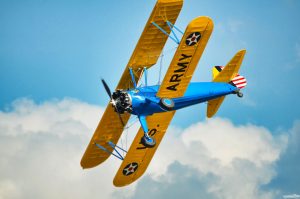
Capt. Walker first flew a Stearman back in 1995, when his friend LeRoy Peterson gave him a ride in his renovated Model 75. He describes the Boeing-Stearman Model 75 as the “strongest airplane ever built. It’s built stronger than a bridge.” He then described what internal and external structures make it so tough, including how moving the wing ribs closer together “beefed it up.”
Aviation expert Budd Davisson2 says that all of the fuselage tubing is as big and thick as a gas pipe, and its tail wheel strut is heavier than the main gear on many larger aircraft. “The gear legs do not flex at all,” he says, explaining that they’re all part of a one-piece construction bolted to the bottom of the fuselage. “The wheels are mounted in axle/strut assemblies that slide up and down in the bottom end of the landing gear legs.” He goes on to say jokingly, “If you feel an overwhelming urge to crash an airplane, this is obviously the one to do it in, since the Kaydet will poke a hole in anything you decide to hit.“2
In addition to being built to survive the punishment student pilots inflict on training aircraft, the Boeing-Stearman was also designed to “wash out pilots,” Capt. Walker says. Out of the hundreds of airplanes Capt. Walker has flown, the most challenging is the Nieuport 17 single-seat biplane (he flew a replica with the Lafayette Escadrille a couple decades ago), and a close second is the Boeing-Stearman Model 75.
The idea was to prepare pilots-in-training for the larger, higher-performance aircraft they would be flying in combat, and so Capt. Walker says the Stearman was built to be intentionally hard to control. With its “tall, narrow gear” and the weight of the fuel in the upper wing, the Boeing-Stearman Model 75’s center of gravity forces you to wrestle it, especially on the ground.
(All specs are for the PT-17)8
| Seats | 2 (tandem) |
| Length: | 24 ft. 9 in. (7.54 m) |
| Wingspan: | 32 ft. 2 in. (9.81 m) |
| Wing Area: | 298 sq. ft. (27.7 sq. m) |
| Height: | 9 ft. 8 in. (2.95 m) |
| Empty Weight: | 1,931 lb. (876 kg) |
| Loaded Weight: | 2,950 lb. (1,195 kg) |
| Fuel | 46 gal (gravity fed, 4-7 gal not available in flight) |
Performance Specifications
The heavy Model 75 PT-17 was fitted with a nearly 500 lb, seven cylinder 220 HP Continental R-670-5 radial engine pulled by a Sensenich wooden propeller. Most still-airworthy Boeing-Stearman’s now have higher-performance metal propellers, like Capt. Walker’s, which has a 102-inch diameter ground-adjustable McCauley propeller.
“Climb performance with an airplane that grosses out very nearly 3,000 lbs and has only 220 horses up front is going to be leisurely. You don’t have any choice.” Budd Davisson
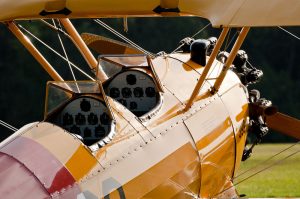
Phil Whittemore of the RAF (Recreational Aviation Foundation), a vocal Boeing-Stearman Model 75 enthusiast who owns two (one with a 220 HP Continental and the other with a 450 HP Pratt & Whitney), offers advice to those looking into flying or buying:
“Absolutely, positively fly one if you have a chance. There is no other plane like it… (But) they want to ground loop, they really do. You have to stay in front of this airplane at all times when it is on the ground, cause if she starts to get away you won’t be able to stop her.“10
He warns pilots against the high rate of pilot error caused accidents when performing wheel landings in the Stearman, and encourages everyone to stick to three-point landings, whenever possible.
“There are three sayings about Stearmans that are the absolute truth.
There are only two types of Stearman pilots, those that have ground looped and those that will.
You are not done flying a Stearman until its in the hangar, the hangar door is closed, and you’ve left the airport.
Even a high time airline pilot (with no taildragger experience) won’t be able to successfully taxi a Stearman the first time.” Phil Whittemore, RAF Liason10
| Max Speed | 117 knots (134.6 mph, 216.7 km/h) |
| Service Ceiling | 13,200 ft (4,023 m) |
| Cruise Speed | 83 knots (95.5 mph, 153.7 km/h) |
| Max Range | 438.8 nm (505 mi, 812.7 km) |
| Fuel Burn | 12-13 gal/hr |
| Climb | Roughly 800 fpm |
Taxiing and Taking Off
Capt. Walker, when asked about the ground handling of the Boeing-Stearman Model 75, admits that tailwheel aircraft don’t handle tailwinds well, and the Stearman handles them even worse. Pilots can be “easily confronted by a ground loop,” says Capt. Walker, and once the Stearman slips out of your control, it’s almost always “unrecoverable.”
Davisson’s experience is that the Boeing-Stearman Model 75 is remarkably easy to taxi, considering how old the design is and how limited the visibility is. He reports that the tailwheel is steerable through 35 degrees, “at which point it kicks out and goes full swivel.” Davisson also says that, if well-maintained, the brake system is “perfectly matched to the airplane’s size and use.”
Capt. Walker warns that if allowed to ground-loop, the Stearman almost always goes around to the left, ruining the right wingtip and aileron.
On take off, Davisson says that he immediately becomes aware of how big and heavy the Model 75 is, despite how it appears to leap off the ground “a long time before it really should.”
Aerobatic Maneuvers
Capt. Walker enjoys aerobatic maneuvers in the Boeing-Stearman Model 75 and says it performs the most beautiful loops. A friend of his once did 100 loops in a row! Capt. Walker says that he’s never been interested in that sort of aerobatic endurance test, but described for me his unique loop procedure. Instead of nosing over to gain speed and then pulling back hard on the yoke, he simply trims using the Flettner tab (used to trim out all the elevator forces) as the airplane accelerates to maximum level-flight speed (between 100 and 110 mph, says Capt. Walker). “Then, not putting any pressure on the control stick, the pilot quickly and forcibly moves the Flettner tab as far as possible as quickly as possible. Up and over you go with little to no loss of altitude. It ain’t pretty, but it is cool!” Capt. Walker explains.
Appropriately, Davisson described stalling in the Boeing-Stearman Model 75 as “gentlemanly,” and explains that “if you force and yank real hard, yes, the stall will break. But when it does break, it doesn’t go anywhere. The Kaydet gives you plenty of time to correct. In a normal stall series, the plane simply drops the nose and mushes ahead until flying speed has been reached.” Speaking of speed, doing any maneuvers that require speed, like loops, necessitates “an awful lot of time going downhill trading altitude for speed.” Davisson says that it takes three or four minutes to regain the altitude lost performing a loop but states that this is not something the bigger horsepower Stearman’s have to worry about.
Similarly, he describes its spinning characteristics as “absolutely textbook in nature,” and “one of the nicest spins of any airplane around.” After stalling the airplane and sliding the ball about “three widths” of center, the Boeing-Stearman Model 75 goes into a spin at a manageable speed, “almost talking to you all the way around about what the handbook says concerning opposite rudder and forward stick.”
Capt. Walker says that though the loop performance is amazing, the Stearman “doesn’t like to roll.” There’s not as much “lateral control,” because the standard Model 75 only has two ailerons per its four wings.
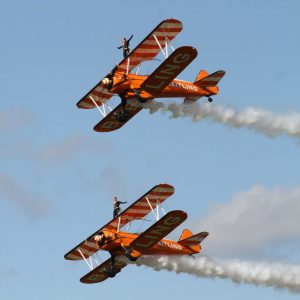
Budd Davisson says he can easily see why “all the airshow performers have converted [their Stearmans] to feature an extra set of ailerons in an effort to jack-up the roll rate.” Here he describes his first English Bunt (described by the International Aerobatics Club as “the second half of a loop downward, this time an outside loop. You push forward and fly the second half of an outside loop till you are in horizontal inverted flight”) in a Stearman:
“The single most unnatural movement that a pilot can make in an airplane is pushing the stick forward from level flight and watching the nose curl under. It was a simple matter of working the nose around until it felt like my intestines were going to extrude through my eardrums, and then rolling out on the bottom as if it were an Immelmann in reverse. This is one area where the Stearman’s high drag certainly works favorably. When you push the Kaydet over to an outside maneuver like that, the plane takes time gaining speed and you have plenty of time to make the corner.“2
PT Variants of the Boeing-Stearman Model 75 Biplane
There are three main models in the PT series; the PT-13, PT-17, and PT-18. Unless stated otherwise, they’re all the same airframe with different engines.5, 8
“When we are busy colonizing outer space, we will probably be relaxing by restoring Stearmans.” Budd Davisson2
PT-13 with a Lycoming R-680 engine – 2,141 built.8
- PT-13 Initial production. R-680-B4B engine, about 215 HP.
- PT-13A R-680-7 engine, about 220 HP.
- PT-13B R-680-11 engine, about 225 HP.
- PT-13C The same as the PT-13B, but modified for instrument flying.
- PT-13D R-680-17 engine, around 225 HP.
PT-17 With a Continental R-670-5 engine, about 220 HP – with 3,519 delivered.8
- PT-17A Modified for instrument flying.
- PT-17B Modified with agricultural spraying equipment.
PT-18 with a Jacobs R-755 engine, about 225 HP- 150 built.8
- PT-18A Modified for instrument flying.
Operating and Purchase Costs
Most Boeing-Stearman Model 75s have been upgraded with stronger, more reliable tailwheel assembly, modern brakes, higher tech radios (Capt. Walker says that instructors used to speak to the student pilot in the front seat through a rubberized tube that ran from their mouth to the students ear. Talk about a one-way conversation!) and more, which raise both the economic and practical value for pilots looking to buy one of their own.
If you accept the higher cost of insuring tailwheel aircraft, the Stearman’s fairly standard fuel burn makes the operating cost about the same as any modern taildragger with the same horsepower. Because it was designed to be flown and maintained by less experienced (and young) flight crews in WWII, it’s exceedingly simple to maintain, and parts are plentiful (but seldom needed, says Davisson).2 A quote from AOPA says an annual can run about $1,000 or so and reminds pilots to keep their Stearman hangared or you’ll be replacing the fabric sooner than you’d like, though you should expect to replace it at some point.6
Though AOPA says6 you can pick up a Stearman for between $75,000-$125,000, a recent scan of three aircraft trading websites (Barnstormers, Trade-a-Plane, Controller) leads me to believe that might be a bit optimistic, with well-maintained Stearmans selling in the $98,000–$160,000 range (and up), with a few cheaper options scattered here and there. One ad for $58,000 caught my eye, before I realized it didn’t have any wings attached. Another for $35,000 blew my mind, but it’s apparently completely disassembled.
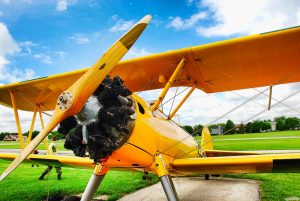
Regardless, this classic biplane warbird with all sorts of potential sells for around the price of a well maintained Piper Super Cub, so it’s not too far-fetched, financially. And if you just want to experience one, they’re very popular with flight tour companies and the like because they’re so much fun to fly, and the open cockpit allows passengers 360-degree visibility.
Final Thoughts on the Boeing-Stearman Model 75
Very few classic warbirds are available in such quantity and quality, and even fewer are sold for prices that don’t trigger heart attacks. According to Capt. Walker, there are probably thousands of Stearmans still flying today (more than the verified thousand or so), all thanks to the crop dusters.
I’ve always been a huge fan of biplanes, and after spending some time (read: hours and hours) looking at pictures and watching videos, I’ve fallen in love with the hearty, visceral radial engines. The Boeing-Stearman Model 75 with the 450 HP engine seems like the perfect airplane, capable of all sorts of aerobatic maneuvers and requiring the pilot to truly fly the whole time, meaning hands and feet moving and brain working. It doesn’t seem like a wise choice of primary airplane for those who like to travel, but if you’re in it to have fun for a couple hours at a time, and look very, very cool doing it, you can’t do much better than the Model 75.
NOTE: If you’re interested in a flight in a Boeing-Stearman Model 75 or many other types of warbirds and live on the West Coast, check out the Commemorative Air Force | Air Base Arizona website, for their tour schedule and flight booking.
References and Resources:
1 – Boeing/Stearman PT-17 “Kaydet,” Warbird Alley, Retrieved 3-30-17
2 – Stearman- The Legend Lives On! Budd Davisson, PIREP, Airbum, Retrieved 3-30-17
3 – Boeing Stearman Model 75/PT-17, Heritage Aircraft, Retrieved 3-30-17
4 – Boeing Stearman Aircraft History, Performance and Specifications, Pilot Friend, Retrieved 3-30-17
5 – Boeing Stearman Technical Details, Stearman by Classic Aviation, Retrieved 3-30-17
6 – The Boeing Stearman: Operating an Iconic WWII Trainer in a Club Environment, Aircraft Spotlight, AOPA, Retrieved 3-30-17
7 – Stearman Kaydet Trainer, Boeing: History, Boeing, Retrieved 4-21-17
8 – Boeing-Stearman Model 75, Wikipedia, Retrieved 3-30-17
9 – Beechcraft T-6 Texan II, Wikipedia, Retrieved 3-31-17
10 – Who’s Flown a Boeing-Stearman? Phil Whittemore, Backcountry Pilot, Retrieved 3-31-17
The prettiest Boeing-Stearman I’ve ever seen: Controller
Focke-Wulf Fw 190: The Butcher Bird of WWII
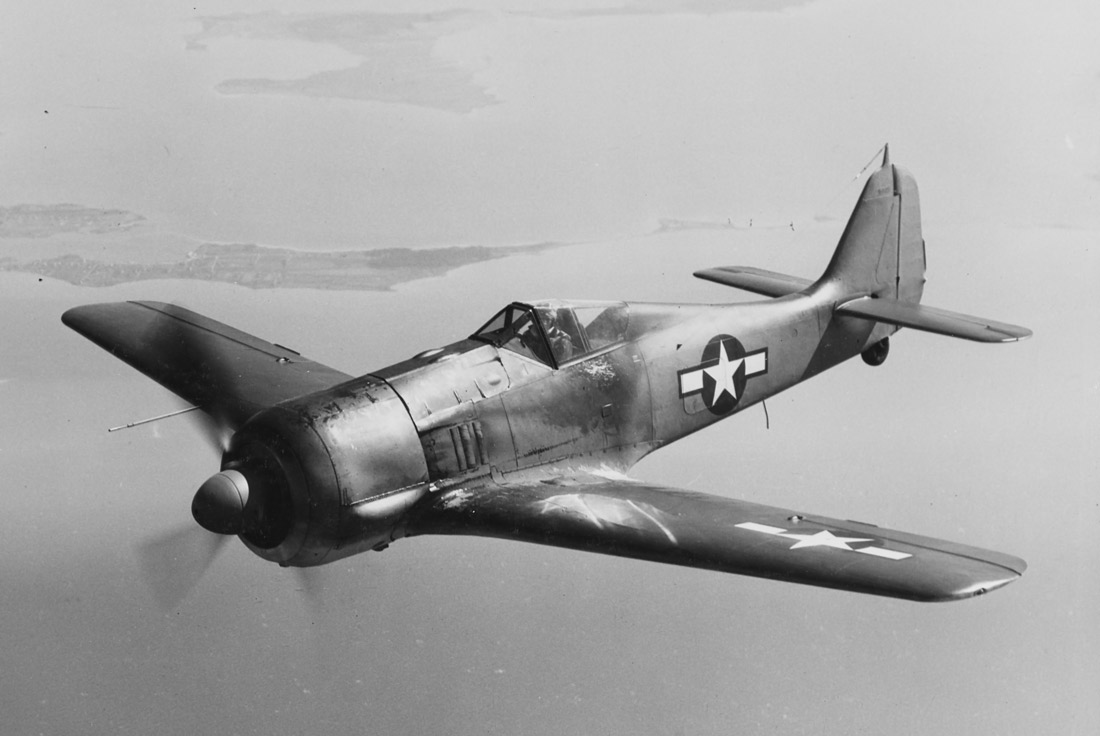 The Focke-Wulf Fw 190 Würger (Shrike in English) has become one of the most iconic military aircraft in world history since it first inspired fear in the Allied forces throughout all of World War II. Named for the shrike (nicknamed the “butcher bird”), a small carnivorous bird of prey known for impaling its prey on spikes, the Fw 190 was one of the only radial engine fighter aircraft used in Europe at the time. Though used successfully by the US Navy, many aeronautical engineers in Europe [Click to read more…]
The Focke-Wulf Fw 190 Würger (Shrike in English) has become one of the most iconic military aircraft in world history since it first inspired fear in the Allied forces throughout all of World War II. Named for the shrike (nicknamed the “butcher bird”), a small carnivorous bird of prey known for impaling its prey on spikes, the Fw 190 was one of the only radial engine fighter aircraft used in Europe at the time. Though used successfully by the US Navy, many aeronautical engineers in Europe [Click to read more…]


